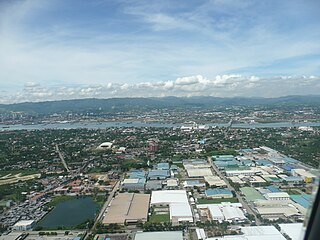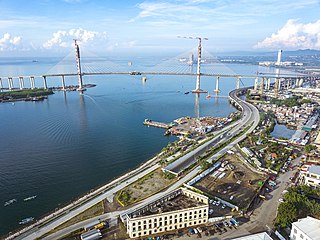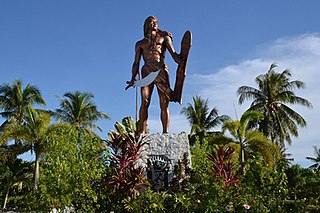Related Research Articles

The Battle of Mactan was a fierce clash fought in the archipelago of the Philippines on April 27, 1521. The warriors of Lapulapu, one of the Datus of Mactan, overpowered and defeated a Spanish force fighting for Rajah Humabon of Cebu under the command of Portuguese explorer Ferdinand Magellan, who was killed in the battle. The outcome of the battle resulted in the departure of the Spanish crew from the archipelago of the Philippines.

Lapulapu or Lapu-Lapu, whose name was first recorded as Çilapulapu, was a datu (chief) of Mactan in the Visayas in the Philippines. He is best known for the Battle of Mactan that happened at dawn on April 27, 1521, where he and his warriors defeated the Spanish forces led by Portuguese explorer Ferdinand Magellan and his native allies Rajah Humabon and Datu Zula. Magellan's death ended his voyage of circumnavigation and delayed the Spanish occupation of the islands by over forty years until the expedition of Miguel López de Legazpi in 1564. Legazpi continued the expeditions of Magellan, leading to the colonization of the Philippines for 333 years.

Lapu-Lapu City, officially known as the City of Lapu-Lapu, is a 1st class highly urbanized city in the Central Visayas region of the Philippines. According to the 2020 census, it has a population of 497,604 people.

Rizal Park, also known as Luneta Park or simply Luneta, is a historic urban park located in Ermita, Manila. It is considered one of the largest urban parks in the Philippines, covering an area of 58 hectares. The site on where the park is situated was originally known as Bagumbayan during the Spanish colonial period. It is adjacent to the historic Walled City of Intramuros.

Marcelo Fernan Bridge, also known as Second Cebu-Mactan Bridge is an extradosed cable-stayed bridge located in Metro Cebu in the Philippines. It spans across Mactan Channel connecting Mandaue City to Lapu-Lapu City in Mactan Island. It is currently the second-longest cable-stayed bridge in the Philippines after Cebu-Cordova Bridge in Cebu City. Before it was named the Marcelo Fernan Bridge, it was called the Consolacion Bridge, named after the Municipality of Consolacion, which is 1.6 miles (2.6 km) from the north end of the bridge.

Metropolitan Cebu, or simply Metro Cebu,, is the main urban center of the province of Cebu in the Philippines. Metro Cebu is located along the central eastern portion of the island including the nearby island of Mactan. It accounts for 19.9 percent of the land area and 61.5 percent of the population of the entire province of Cebu.

Mactan–Benito Ebuen Air Base, originally known as Mactan Air Base, is an active military airbase of the Philippine Air Force (PAF). It is located on the island of Mactan, Cebu, in the Visayas region of the Philippines. It shares its single runway with the civilian Mactan–Cebu International Airport. Mactan Air Base was originally built by, and was a facility of the United States Air Force (USAF), until the American military units left the country in 1991, whereby full and total control was handed over to the Philippine Air Force.
Rajah Humabon, later baptized as Don Carlos, was the Rajah of Cebu. Humabon was Rajah at the time of the arrival of Portuguese-born, Spanish explorer Ferdinand Magellan in the Philippines in 1521. There is no official record of his existence before the Spanish contact in 1521. The existing information was written by Magellan's Italian voyage chronicler, Antonio Pigafetta on Humabon and the indigenous Philippine peoples that existed prior to Spanish colonization.

Historical markers are installed by the National Historical Commission of the Philippines (NHCP) in the Philippines and places abroad that signify important events, persons, structures, and institutions in Philippine national and local histories. The plaques themselves are permanent signs installed by the NHCP in publicly visible locations on buildings, monuments, or in special locations. Local municipalities and cities can also install markers of figures and events of local significance. Though they may have the permission of the NHCP, these markers are barred from using the seal of the Republic of the Philippines.

The Statue of the Sentinel of Freedom or the Lapu Lapu Monument is a monument to Lapulapu located at Rizal Park specifically at the center of the Agrifina Circle.

The Cebu–Cordova Link Expressway (CCLEX), also known as the Cebu–Cordova Bridge and the Third Cebu–Mactan Bridge, is an 8.9-kilometer (5.5 mi) toll bridge expressway in Metro Cebu. The bridge connects the South Road Properties in Cebu City in mainland Cebu, and Cordova, on Mactan island. Crossing the Mactan Channel, it is the third road link between Cebu and Mactan islands, and the first between Cebu City and Cordova. It is the longest sea-crossing bridge in the Philippines, surpassing the 2-kilometer (1.2 mi) San Juanico Bridge between Samar and Leyte, as well as Marcelo Fernan Bridge as the longest cable-stayed bridge in the Philippines.

Mactan–Cebu International Airport is the second busiest international airport in the Philippines. It is located on a 797-hectare (1,970-acre) site in the city of Lapu-Lapu on Mactan, a part of Metro Cebu and serves the Central Visayas region. The airport is managed by the Mactan–Cebu International Airport Authority and serves as a hub for Cebu Pacific, Pan Pacific Airlines, and Royal Air Philippines.
The New Generation Currency (NGC) Series is the name used to refer to Philippine peso banknotes issued since 2010 and coins issued since 2018. The series uses the Myriad and Twentieth Century typefaces.

Mactan Shrine, also known as Liberty Shrine, is a memorial park on the island of Mactan in Lapu-Lapu City, Cebu, Philippines. It hosts two monuments, namely the Magellan Monument, which is dedicated to Portuguese explorer Ferdinand Magellan and the Lapu Lapu Monument, a bronze statue which commemorates Lapu Lapu, a native leader who defeated Spanish soldiers led by Magellan in the 1521 Battle of Mactan.

The 2021 Quincentennial Commemorations in the Philippines is a series of observances organized to mark the 500th anniversary of various events in the Philippines, notably the introduction of Christianity in the Philippines, the role of the country in the Magellan–Elcano circumnavigation, and the victory of Lapulapu in the Battle of Mactan.
"Panalo" (transl. "Victory") is a song by Filipino-American rapper Ez Mil, released on July 26, 2020, as the fifth track on the album Act 1. It features lines in three languages: Filipino/Tagalog, English, and Ilocano in the original Wish 107.5 recording with an addition of Cebuano for the following Pacquiao Version official music video release.

The 500 Years of Christianity in the Philippines is a quincentennial observed in the Philippines. It commemorates the introduction of Christianity in the Philippines in 1521 when the Magellan expedition made a stopover in the islands.
References
- 1 2 Dumaboc, Fe Marie (November 15, 2019). "Structures obstructing Lapu-Lapu Shrine to be demolished". Philippine News Agency. Retrieved January 8, 2021.
- ↑ Alipon, Joworski (November 14, 2019). "National Historical Commission to improve Lapulapu monument in Cebu". ABS-CBN News. Retrieved May 6, 2021.
- ↑ Ranada, Pia (September 14, 2019). "Lapulapu statue in Cebu to be replaced in 2021". Rappler. Retrieved May 6, 2021.
- 1 2 3 Abuan, Alehia. "NQC launches Lapulapu National Monument Design Competition". pia.gov.ph. Philippine Information Agency. Retrieved May 6, 2021.
- 1 2 Erram, Morexette Marie (July 23, 2020). "Historians unveil Lapulapu Shrine and Museum project". Cebu Daily News. Retrieved January 8, 2021.
- ↑ "Quincentennial committee unveils new design for Lapu shrine, museum". Cebu Daily News. July 18, 2020. Retrieved May 6, 2021.
- 1 2 "'The Watch of Mactan' picked as design for Lapu monument". Sunstar. March 1, 2021. Retrieved May 6, 2021.
- ↑ "Press Briefing of Presidential Spokesperson Harry Roque". News and Information Bureau-Data Processing Center (in Tagalog). Presidential Communications Operations Office. April 27, 2021. Retrieved May 6, 2021.
- ↑ "NFC participates in the 500th Quincentennial Commemorations of the Victory at Mactan". April 30, 2021. Retrieved May 6, 2021.
- ↑ Chua, Johannes (April 28, 2021). "Look: Winning Lapulapu monument design by a young Tarlac-based architect". Manila Bulletin. Retrieved May 6, 2021.
- ↑ Aning, Jerome (January 19, 2022). "Duterte's stand: Make Lapulapu shrine taller than Magellan's". Philippine Daily Inquirer. Retrieved February 15, 2022.